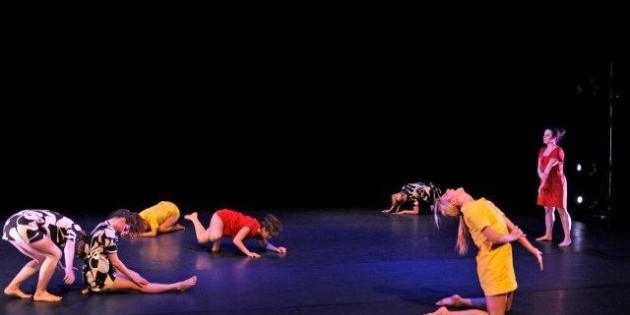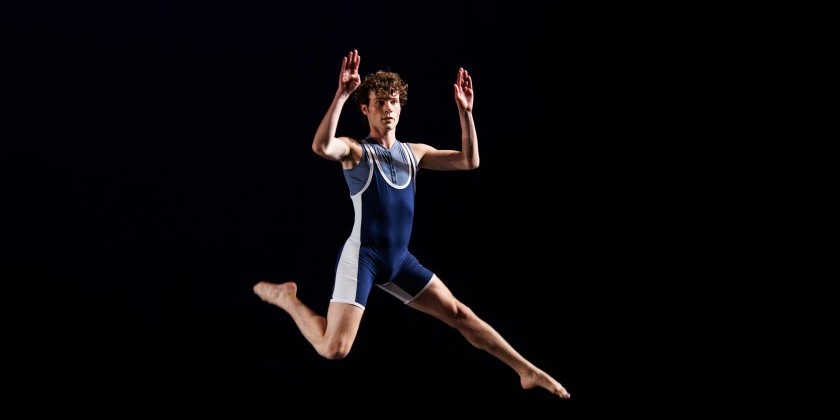IMPRESSIONS: La MaMa Moves! Dance Festival Presents Jessica Cook / Alex Romania + Stacy Lynn Smith

La MaMa Moves! 2025
Shared Program: Jessica Cook / Alex Romania + Stacy Lynn Smith
Guest Curators: Martita Abril and Blaze Ferrer
May 1 - 3, 2025 @ The Club
Wedge
Choreography and Performance: Jesi Cook
Performing May 1st: Jesi Cook, Ayano Elson and Amelia Heintzelman
Performing May 2nd and 3rd: Jesi Cook, Ayano Elson, and Mina Nishimura
fame hOle
Concept and Performance: Psychic Wormhole (Alex Romania and Stacy Lynn Smith)
Sound: Ava Vex
After arriving on La MaMa Experimental Theatre Club's second floor, we settle into a dimly lit room, where I situate myself on a long row of risers. A small cluster of chairs flanks the entrance. Without a defined front, the space invites openness.
Two ladders immediately capture our attention — one planted at center stage, the other stationed opposite the entrance. A small microphone perches atop the central ladder, while a larger, freestanding one stands beside the second. A large table stretches between them, grounding the space.

Jesi Cook's trio Wedge, a whirlwind of structured improvisation, emerges from the shadows. It opens in near darkness, with quiet, slithering movements. A bright spotlight suddenly flares across the back wall and trickles downward, revealing Mina Nishimura. Cook stands poised on the far ladder, while Ayano Elson enters last. At first, the performers seem isolated — each existing in their own world — until breath and rhythmic pulses slowly draw them into sync.
As the lights brighten, their movement intensifies: crawling, writhing, then stomping and pressing into one another’s bodies. I grow captivated by how they weave and dart through the space. They climb onto the table, stamping their feet with clarity and force.

A particularly striking moment arrives when Nishimura ascends the central ladder, and presses her mouth to the microphone. She crinkles a bag of a dried snacks, and begins to chew. The sound, amplified and intimate, carries a strange sensuality. Crumbs scatter across the floor, heightening the sense of frenzy.
Screams erupt repeatedly. Sometimes we make out words (“I’m lost! Me too!”), but more often raw shouts jolt us becoming a recurring motif. Our attention splinters, constantly drawn in new directions as the dancers sprint, collide, and rebound across the space.
What first registers as chaos gradually reveals a skeleton of structure. A series of electronic beeps cues the trio into synchronized movement, only for them to abandon it later, diving back into visceral, unpredictable motion.

Eventually, house lights rise. The performers guide us out of the theater and into La MaMa’s lobby. There, they launch into a final, elastic dance at the building’s entrance before vanishing. Without pause, we transition into the next work, fame hOle, by Psychic Wormhole (Alex Romania and Stacy Lynn Smith).
In the lobby, a projection screen streams live footage of a car parked outside, its body wrapped in a blank canvas. Some audience members drift outdoors. Inside, we watch as others — perhaps including passersby — begin to spray — paint the vehicle using cans left nearby. Even if this activity is staged, the invitation feels open. Rainbows, smiles, frowns, and stars emerge. Someone sprays “FRIEND” in red.

Outside, the car morphs into a stage. The hatchback door, bearing a screen that reads THERE IS NOTHING GOOD OR GREAT ABOUT SAYING IT in front of it, swings up to reveal Romania and Smith. Clad in neon hues, masks, and sunglasses, they radiate extraterrestrial energy. Props surround them: cameras, microphones, dismembered toy limbs, and other colorful oddities.
The performance flows as much through speech as movement. Their surreal dialogue, aimed both at us and at each other, paints a dystopian landscape — portraying society’s present and possible futures. The work echoes themes from the choreographers’ upcoming film RECKONING, which, according to a program note, serves alongside fame hOle as “a visceral abstract memoir of Smith’s survivorship of childhood sexual abuse and Complex-PTSD.”
A cryptic script projects across the trunk’s screen:
“2 and 1 are sitting at the helm of the ‘starship’. They are thrust forward in their story that nobody is following clearly anyway… we are thrust forward to the moment when these characters are crossing the event horizon to the black hole where they are supposed to be travelling to save humanity… but somehow got distracted by the metaphysical problem…”
Romania and Smith press forward, alluding to power, transformation, and the cosmic unknown.

Romania reclines, half-hanging from the trunk, and pulls out a rotisserie chicken. He begins to eat. Smith shrieks, “That’s my body!” again and again, as he continues devouring it. Romania then steps out, balances the chicken atop a tripod, and strips down to his undergarments. He dances: bold, fully present.
The piece culminates with Smith climbing on the car’s roof and proclaiming to the block, “THE WORK IS NEVER DONE!” We leave charged. The once-blank vehicle now vibrates with meaning — transformed into a vessel of time travel, resistance, and regeneration.










![IMPRESSIONS: Will Rawls' [siccer] at the Keith Haring Theatre, Performance Space New York](/images/features_large/20251119_WillRawls_siccer_PerformanceSpaceNY_WhitneyBrowne--55.jpg)

